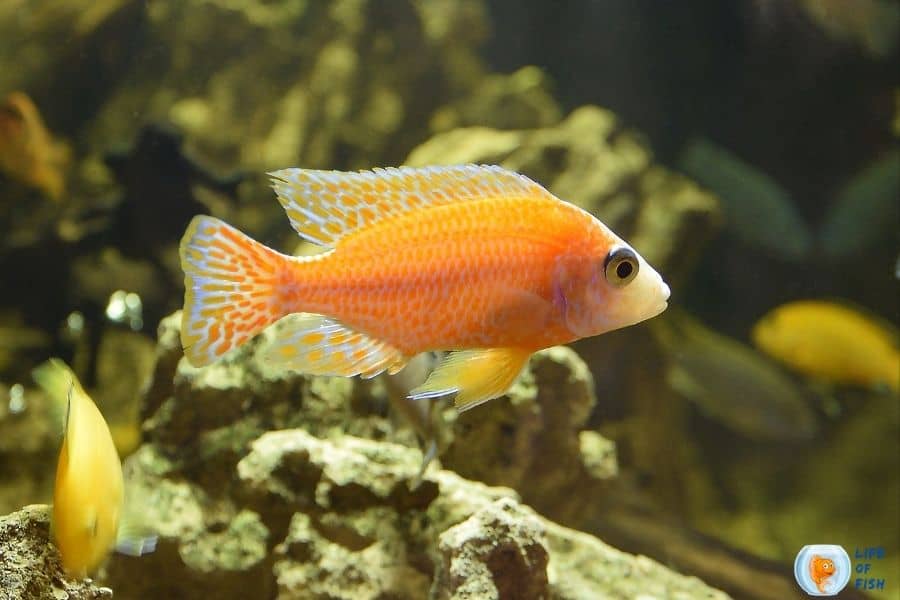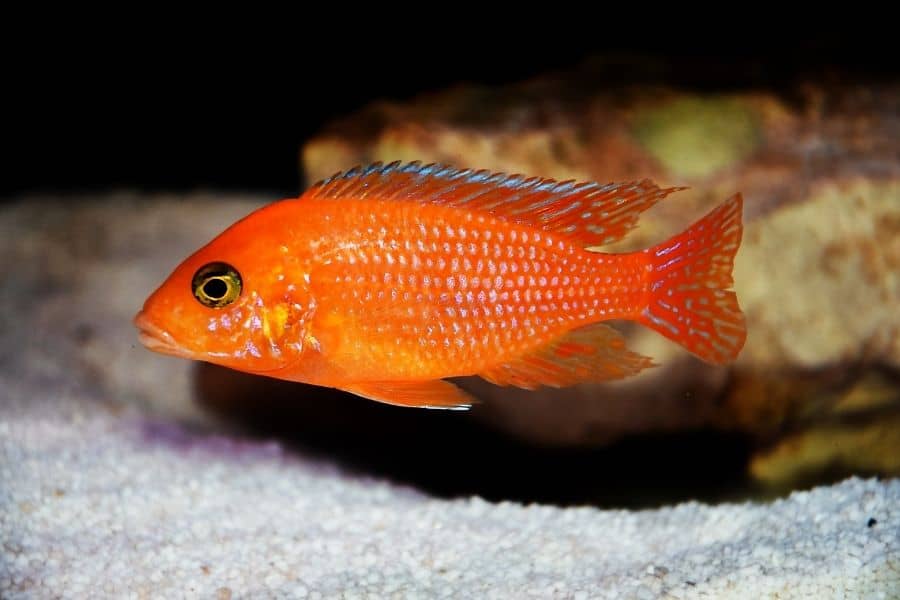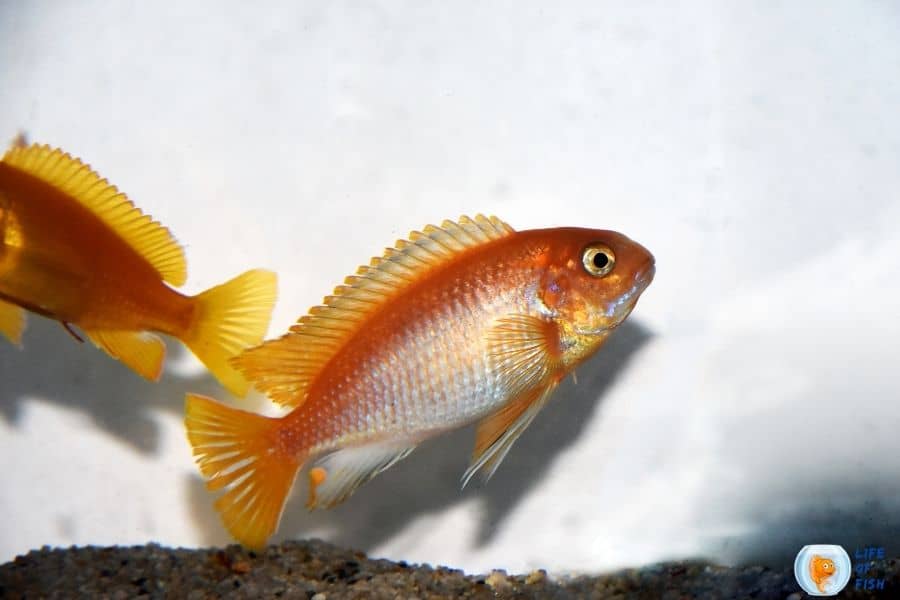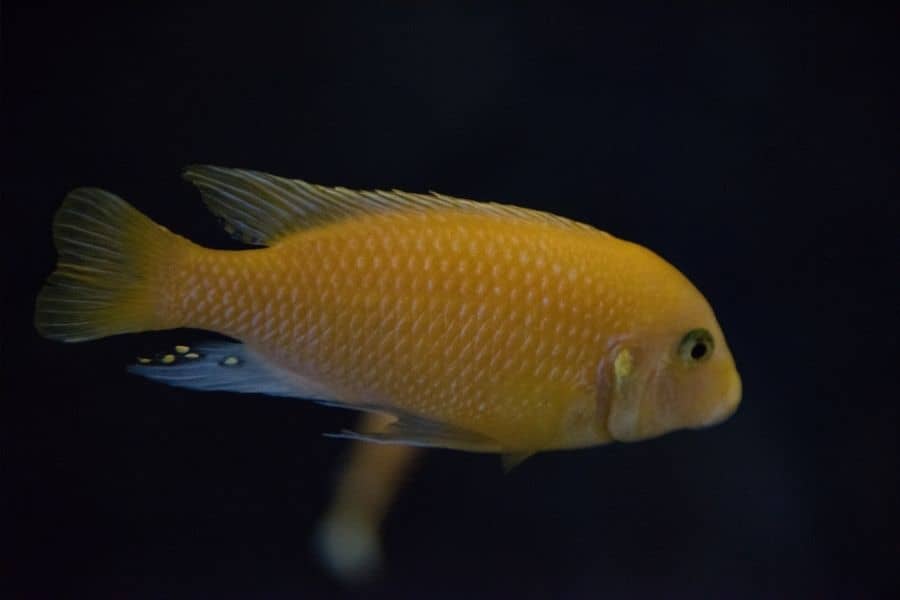One of the most popular cichlid species in the aquarium hobby, Red zebra cichlid, is suitable for intermediate and experienced aquarists.
Although these Mbuna species are endemic to Lake Malawi of Africa, red zebra cichlids are not as aggressive as other Mbuna species. Therefore, they are moderately easy to care for but have high demands.
These beautiful fish require good water conditions and appropriate tank mates to thrive in captivity.
So, it will be lots of work cleaning the tank and doing frequent water changes. They are rewarding to keep as a pet fish for those who do not mind extra work.

What is a red zebra cichlid?
Jump To
- 1 What is a red zebra cichlid?
- 2 How big do red zebra cichlid get?
- 3 Is red zebra cichlid aggressive?
- 4 Red zebra cichlid behavior
- 5 How long do red zebra cichlids live?
- 6 Red zebra cichlid care
- 7 Red zebra cichlid breeding
- 8 Special tips
- 9 How to feed red zebra cichlid?
- 10 What fish can live with red zebra cichlid?
- 11 Related Questions
- 12 Conclusion
Maylandia estherae is a Mbuna cichlid species from Lake Malawi in Africa. Mbuna means “rockfish” or “rock-dwelling” in the Tonga language, which explains where these fish live.
You can often find this fish on the eastern coast of Malawi Lake. They live among rocks.
They belong to the genus Maylandia and the family Cichlidae. However, the taxonomic status of these species is under review as they might be placed in the genus Pseudotropheus.
Red zebra cichlids are a polymorphic species. Hence they display different colors and patterns.
In the wild, male red zebra cichlids are light blue, while female color ranges from brownish beige to orange-red. The females lack vertical bars in their bodies.
Captive-bred colors are a lot more varied than wild fish. They can be brown, brown, blue, yellow, orange, and pink with or without vertical bars and mottling.
These color strains can often be confusing that most pet shops label these fish as “African Cichlid” or “Assorted African Cichlids.”
But it is important to identify the exact species because different cichlid species have different care requirements.
How big do red zebra cichlid get?
Is red zebra cichlid aggressive?
Most cichlid species are very aggressive and nippy fish, but they are not. They bully other fish only if they are not well fed.
So, it is advisable to keep red zebra cichlids alone or with other cichlid species with the same temperament.
Red zebra cichlid behavior
They are semi-aggressive species that do not show aggression towards other cichlid species.
However, they can attack or interbreed with other cichlid species if they are in the same size range, which is not suggested.
Although these cichlids are not aggressive as other Mbuna species, they are highly territorial.
If other fish species enter the tank, red zebra cichlids display aggressive behavior. So, it is advisable to add them to a spacious aquarium.
They do not do well in community tanks. As they need much space to establish their territory, other fish will become bullied. However, these fish will do well with their own species. In fact, they love to stay in schools.
They are omnivore fish but prefer a highly vegetarian diet. Further, these fish are voracious eaters.

How long do red zebra cichlids live?
It lives up to 10 years in the aquarium, which doubles their lifespan if kept in the wild.
Red zebra cichlid care
If you do not mind regular water changes and having a large aquarium, Red zebra cichlids are not a hard fish species to care for.
They do well in a species-only tank with tropical water conditions.
Red zebra cichlid size
They are medium-sized fish species.
Males grow up to 3.9 inches (10.1 cm) in length, and females grow up to 2.4 inches (6.1 cm) in length.
Male red zebra cichlids are bigger than the females and have brighter colors, while females look more brownish with some yellow.
Red zebra cichlid tank size
A minimum size tank for it is 55 gallons or 208 L.
How many red zebra cichlids should be kept together?
They prefer to live in groups. Therefore, you should keep about four fish or more in your fish tank.
However, there can be only one male specimen with 2 to 3 females as Red Zebra cichlids show male to male aggression, like other cichlid species.
Tank setup
They need highly mineralized water to thrive in captivity like any other lake Malawi fish.
They prefer a rocky environment like their natural habitats. Therefore, you need to build your tank with a lot of rocks.
Substrate
You can use any substrate in your tank, but we recommend using crushed coral or sand used for saltwater tanks as the substrate because they can increase the pH level of the water, which is a must for Lake Malawi fish.
If you plan to change the pH level by other means, you can use gravel as the substrate.
Decorations
In Mbuna cichlids tank, rocks are a must-have addition. You should add some rocks to create cave-like structures where your cichlids can hide and establish their territory. However, you can decorate your tank with other things too.
But be careful when you add other decorations to your tank. Your red zebra cichlids might not like them, and they may try to attack them, which may cause physical injuries to your fish.
Filtration
Filtration is necessary for red zebra cichlids because they need clean water conditions to thrive. If given poor water conditions, it may cause health issues to them.
Water circulation
A strong water current along with a sound filtration system will provide your cichlids’ comfort and optimal living conditions.
Lighting
They are diurnal fish species, which means they are active during the day. You need to provide your red zebra cichlids with moderate light during the day so they can find their food easily.
Tank lid
Although red zebra cichlids are not regular jumpers, they jump in the tank when they feel like it. Therefore, you should make sure your tank has a secure lid.
Water quality condition
Their natural water habitats contain temperate, highly mineralized water. You should therefore provide the same water conditions in captivity. If not, these fish will suffer and eventually die.
Their natural habitats do not contain saltwater but, these fish have a slight tolerance for saltwater. It is not recommended to keep them with seawater, but if you want to do so, salinity should be less than 1.0002.
Lake Malawi is well known for its high pH levels. So, the fish that comes from there also need highly alkaline water conditions to survive.
pH level should be around 7.7 to 8.6, and the water hardness should be between 6 and 10 dGH.
Since your tank will have high pH levels, the Ammonia will be more lethal. Therefore, you must do regular water changes to keep your tank clean.
Lake Malawi has a hot water condition essential for red zebra cichlids. The water temperature should be between 73.0 and 82.0° F (22.8 and 27.8° C).
Additionally, you should vacuum the substrate with a 30% water change every two weeks.

Red zebra cichlid breeding
They are an easy-to-breed fish species in captivity.
They are mouth-brooding fish that readily reproduce when conditions are favorable. Red zebra cichlids sexually mature when they reach 3 inches.
Red zebra cichlid male or female identification
The coloration of male and female cichlids is very distinct. There are mainly three main color morphs in male fish.
- “red-blue” strain- Adult males are light blue with faint vertical bars and 4 to 7 blotches in the anal fin. Juvenile males are dark brown, and juvenile females are pale pink.
- “red-red” strain- Adult males, are orange/red with no vertical bars. Juvenile males look like females, and they develop a light blue shade when they reach about 2.5 inches.
- “albino” strain- Albino color throughout the body, but this color morph is rare.
The adult females are typically yellow, orange, or orange with dark markings. They might have one to three egg spots on their anus fin, which can be seen in both strains.
Identify pregnant red zebra cichlid and red zebra cichlid pregnancy stages
They usually have a muscular body like any other Mbuna species. So, when the female is pregnant, it might be hard to distinguish them from non-pregnant females.
However, there will be a slight bump underneath the female fish when pregnant.
Once the female fish lays eggs, she immediately takes them to the mouth and fertilizes them with the “milt.”
Then she carries fertilized eggs in her mouth for about 2 to 3 weeks until the eggs hatch and fries develop into the free-swimming stage.
During this time, she will not eat anything and only focus on taking care of her breeding group. Even after releasing the fry, females will continue to protect the babies until they can fend for themselves.
Red zebra cichlid breeding
To breed red zebra cichlids, you must condition them by feeding a high-quality diet two times per day.
Separating males from females is not needed, and they will start to spawn once the conditions are right. You should ensure that the water conditions are favorable and that the fish have plenty of rocks and caves to spawn.
Even after providing all their needs, sometimes these fish do not spawn. This is most likely because aggressive fish prevent the other fish from breeding.
Once you remove that aggressive fish, the other fish will start spawning with one another.
When your cichlids are ready to breed, the male fish will build a nest encouraging the females to lay eggs. This will usually be a flat surface, a rock, or a cave, and the male fish will defend this space.
The male fish will then lure the females into his territory by showing off the vibrant colors of his body.
Once the female finishes laying eggs, she takes them back to her mouth. This is called mouthbrooding. Then the male fertilizes the eggs by injecting “milts” (sperms) into the female’s mouth.
How many babies do red zebra cichlid have?
Females lay about 20 to 30 eggs in one spawning.
Red zebra cichlid fry care
Once the red zebra cichlids give birth, the female will take all the babies into her mouth.
The fry will stay in their mother’s mouth for about 1 to 2 weeks until they are developed enough to resemble an adult cichlid.
During this time, the female fish will not eat anything, and she must be well supplied with live food to feed her babies.
When you separate the fry from their mother, they must be put in a tank with no other fish. A 10g tank is suitable for about 5 to 10 fry.
Red zebra cichlid breeding tips
- They have high ecological requirements, so you must provide the right water conditions to breed them.
- Provide plenty of rocks and caves for them to spawn. Having more female fish with only one male fish in the tank can increase your chances of breeding.
- When the male fish builds a nest in his territory, he might become aggressive towards other fish. So, remove any other fish from the tank and only put the breeder fish and their mates in the tank.
Only feed your cichlids high-quality food such as frozen brine shrimp and blood worms. - When the female fish is ready to breed, you can see her chasing other female fish away from her territory.
Special tips
Since red zebra cichlids are highly territorial fish, you should change the rock work once a month to reduce aggression. This way, the fish will not establish a territory and fight each other.
You should provide your red zebra cichlids with lots of hiding places to reduce their stress and prevent them from injuring each other.
How to feed red zebra cichlid?
They are omnivore fish that prefer to eat more plant-based food than meat forms. The Red Zebra consumes a wide range of tiny benthic invertebrates and zooplankton in the wild.
You can feed them with pellets, flakes, vegetables, and live foods such as mysis and brine shrimp in captivity. But, ensure that most of their diet contains vegetable matter because these fish require them to keep their colors strong.
Feeding your red zebra cichlid is not difficult as they accept anything you give them. But, it is vital to feed them with the right food so they remain healthy and strong
You should not overfeed your red zebra cichlids because they can easily become overweight, which is not good for them.
Unlike the general rule of feeding, these fish prefer several small feedings during the day.
You can also add vitamins and supplements to their diet to ensure their health. However, too much protein and fat can cause bloating in your fish, which can be fatal.

What fish can live with red zebra cichlid?
They are not good community fish. They will fight and bully other fish species in the tank.
However, they can be kept with other cichlids that are large enough to protect themselves against bullying. However, other cichlids species should not resemble the male red zebra cichlid; otherwise, they will fight to the death.
And also, you should not house different cichlid species that are similar sized and shaped as red zebra cichlid as they can interbreed, which is not suggested.
Red zebra cichlids do well in a species only tank. However, you must maintain the male population at a very low level to be happy.
The recommended amount for a 55-gallon tank is one male with 2 to 3 females. If you want more males in one tank, the tank should be larger. Otherwise, you will find yourself with dead fish.
Related Questions
Are red zebra cichlids rare?
Red zebra cichlids are listed as a vulnerable species in the IUCN Red List. However, they are very common in the aquarium trade due to their ease of breeding in captivity.
How long does a red zebra cichlid live?
Red Zebra Cichlids have an average life expectancy of 5 to 10 years in captivity.
Conclusion
Red zebra cichlids are beautiful, colorful, and suitable for fishkeepers who have experience in keeping cichlids.
Red zebra cichlids are relatively easy to care for if they are given a clean water condition and plenty of hiding spaces. But, care must be taken as they are moderately aggressive and highly territorial.
Read Next : Auratus Cichlid | Most Terrorizing Fish I Purchase | Black Ram Cichlid Care | 11 Astonoshing Fish Care Tips | Featherfin Cichlid (Cyathopharynx Furcifer) | 13 Rare Facts |
